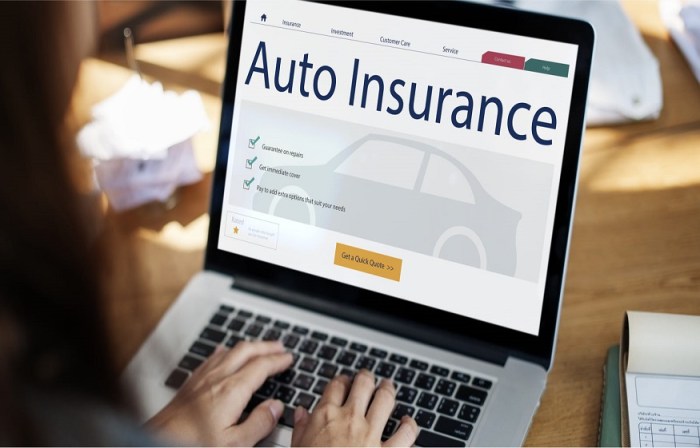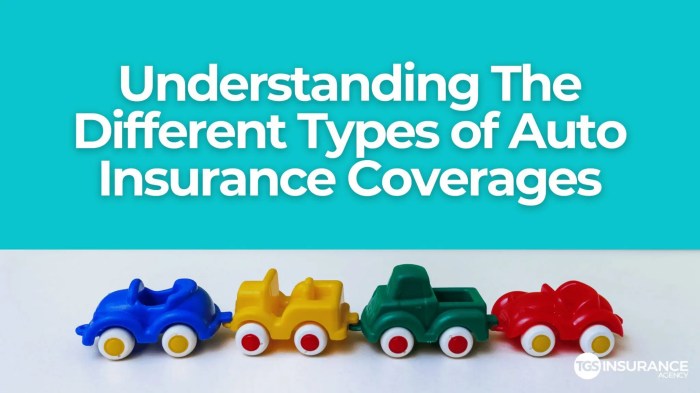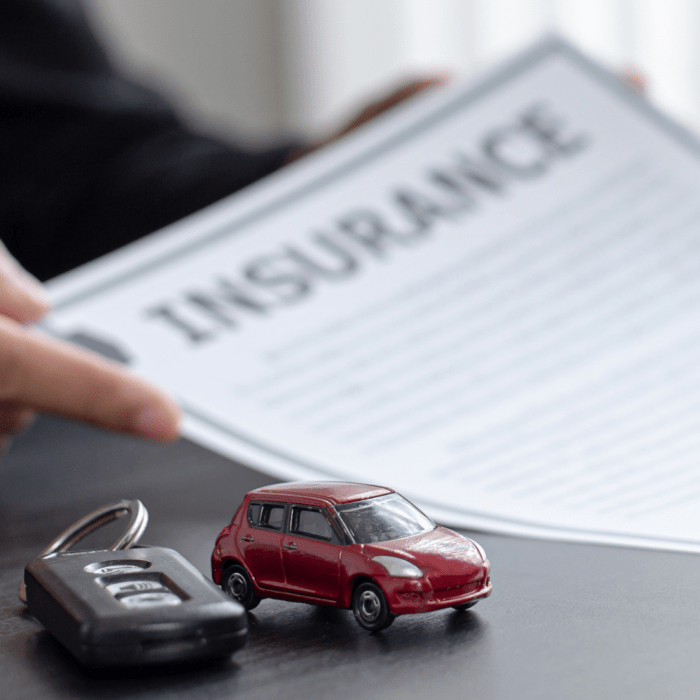The unexpected can happen on the road, turning a routine commute into a costly event. Understanding auto insurance isn’t just about fulfilling legal requirements; it’s about safeguarding your financial future. This guide delves into the diverse landscape of auto insurance types, equipping you with the knowledge to make informed decisions and secure the right coverage for your needs and budget. We’ll unravel the complexities of liability, collision, comprehensive, and other crucial coverages, explaining their implications and helping you choose a policy that provides peace of mind.
From the fundamental concepts of risk assessment and liability limits to the nuances of optional coverages like roadside assistance and rental reimbursement, we’ll explore every aspect of auto insurance. We aim to empower you to confidently navigate the insurance world and select a policy that perfectly aligns with your individual circumstances and driving habits. By the end of this guide, you’ll be equipped to compare quotes, understand policy details, and make an informed choice that protects you and your vehicle.
Introduction to Auto Insurance Types

Auto insurance is a contract between an individual (the policyholder) and an insurance company. In exchange for regular payments (premiums), the insurance company agrees to cover certain financial losses resulting from car accidents or other covered incidents involving the insured vehicle. This protection safeguards the policyholder from potentially devastating financial burdens.
Individuals purchase auto insurance for several key reasons. Primarily, it provides financial protection against liability for accidents. If a policyholder causes an accident resulting in injuries or property damage to others, their auto insurance will cover the costs of legal defense, medical bills, and property repairs, up to the policy limits. Beyond liability, auto insurance often covers damage to the policyholder’s own vehicle in various circumstances, protecting against the expense of repairs or replacement. In some cases, it even covers injuries sustained by the policyholder and passengers in their own vehicle. Furthermore, some policies offer additional benefits like roadside assistance or rental car coverage.
Risk assessment is fundamental to auto insurance. Insurance companies carefully evaluate various factors to determine the likelihood of an individual making a claim. These factors include driving history (accidents, tickets), age, location (accident rates in the area), vehicle type (safety features, repair costs), and driving habits (mileage). Based on this assessment, the insurance company assigns a risk score, which directly influences the premium amount. Higher-risk drivers pay more because the probability of them filing a claim is deemed higher. For example, a young driver with a history of speeding tickets will typically pay more than an older driver with a clean record.
Types of Auto Insurance Coverage
Auto insurance policies typically bundle several types of coverage. Understanding these different coverages is crucial for choosing a policy that adequately protects your financial interests. The main categories include:
Liability Coverage: This covers the costs associated with injuries or damages you cause to others in an accident. It’s usually divided into bodily injury liability (covering medical expenses for injured parties) and property damage liability (covering repairs to damaged vehicles or property). Liability coverage is often legally mandated, and its limits are expressed as numerical amounts, such as 100/300/100 (meaning $100,000 per person for bodily injury, $300,000 per accident for bodily injury, and $100,000 for property damage).
Collision Coverage: This pays for repairs or replacement of your vehicle if it’s damaged in an accident, regardless of who is at fault. If you hit another car or a tree, collision coverage will typically cover the damage to your vehicle, minus any deductible you have chosen.
Comprehensive Coverage: This protects your vehicle from damage caused by events other than collisions, such as theft, vandalism, fire, hail, or natural disasters. For example, if a tree falls on your car during a storm, comprehensive coverage would typically pay for repairs.
Uninsured/Underinsured Motorist Coverage: This coverage protects you if you’re involved in an accident caused by an uninsured or underinsured driver. It covers your medical expenses and vehicle damage, even if the other driver is at fault and lacks sufficient insurance to cover the costs.
Medical Payments Coverage (Med-Pay): This coverage helps pay for medical bills for you and your passengers, regardless of fault, following an accident. It is supplemental to health insurance and may cover expenses not covered by your health plan.
Personal Injury Protection (PIP): PIP coverage pays for medical bills and lost wages for you and your passengers, regardless of fault. In some states, PIP also covers expenses for other people in your vehicle, regardless of fault. The coverage amount varies by state and policy.
Uninsured/Underinsured Motorist Coverage

Uninsured/Underinsured Motorist (UM/UIM) coverage is a crucial component of a comprehensive auto insurance policy, offering protection against financial losses stemming from accidents involving drivers who lack sufficient or any liability insurance. This coverage safeguards you and your passengers, as well as your vehicle, in situations where the at-fault driver is either uninsured or underinsured. Understanding the nuances of this coverage is essential for securing adequate financial protection.
Uninsured/Underinsured Motorist Bodily Injury Coverage protects you and your passengers for medical expenses, lost wages, pain and suffering, and other related costs resulting from an accident caused by an uninsured or underinsured driver. This coverage kicks in to compensate for your losses even if the other driver is at fault but lacks the necessary insurance to cover your damages. The amount of coverage you purchase is determined by your policy limits, which are typically expressed as a per-person and per-accident limit (e.g., $100,000/$300,000).
Uninsured/Underinsured Motorist Bodily Injury Coverage Details
This coverage compensates for medical bills, lost wages, rehabilitation costs, and pain and suffering incurred by you and your passengers due to injuries sustained in an accident caused by an uninsured or underinsured driver. The policy’s limits dictate the maximum amount your insurance company will pay. It’s important to choose limits that reflect the potential severity of injuries and related expenses. For example, a policy with lower limits might not fully cover extensive medical treatment or long-term rehabilitation.
Uninsured/Underinsured Motorist Property Damage Coverage protects your vehicle against damage caused by an uninsured or underinsured driver. This coverage will pay for repairs or replacement of your vehicle, up to your policy’s limits, even if the other driver is at fault and lacks sufficient insurance. It’s vital to remember that this coverage only addresses damage to your vehicle; it doesn’t cover bodily injury claims.
Uninsured/Underinsured Motorist Property Damage Coverage Details
This coverage addresses the financial burden of repairing or replacing your damaged vehicle. The amount reimbursed depends on the extent of the damage and your policy’s limits. For instance, if your vehicle is totaled, the payout will be limited to the actual cash value of your car at the time of the accident, less your deductible.
Real-World Example of UM/UIM Coverage
Imagine you’re stopped at a red light when a driver runs a red light and crashes into your car. The other driver admits fault, but you later discover they have no insurance. With UM/UIM coverage, your insurance company will step in to cover your medical bills, lost wages, vehicle repairs, and other related expenses, preventing you from shouldering the financial burden alone. Without this coverage, you would be responsible for all costs associated with the accident.
Importance of UM/UIM Coverage in High-Risk Areas
In areas with high rates of uninsured drivers, UM/UIM coverage becomes even more critical. These areas may have higher accident rates in general, increasing the likelihood of being involved in a collision with an uninsured motorist. Purchasing adequate UM/UIM coverage provides a crucial safety net in these higher-risk environments, mitigating the financial consequences of an accident caused by an uninsured or underinsured driver.
Final Review

Choosing the right auto insurance policy is a crucial decision, impacting your financial well-being in the event of an accident. This guide has explored the various types of auto insurance coverage available, highlighting their benefits, limitations, and the factors that influence premiums. By understanding liability, collision, comprehensive, and other optional coverages, you can now confidently assess your risk profile and select a policy that adequately protects you while fitting within your budget. Remember, comparing quotes and carefully reviewing policy details before committing is essential to ensuring you have the right coverage at the right price.
Common Queries
What is the difference between actual cash value (ACV) and replacement cost coverage for my car?
ACV pays the current market value of your vehicle minus depreciation, while replacement cost covers the cost of a new vehicle of similar make and model. Replacement cost is typically more expensive but offers better protection.
How does my driving record affect my auto insurance premiums?
A clean driving record with no accidents or tickets generally leads to lower premiums. Accidents and traffic violations increase your risk profile, resulting in higher premiums. The severity and frequency of incidents significantly impact the cost.
Can I get auto insurance if I have a DUI on my record?
Yes, but it will likely be significantly more expensive. Insurance companies consider DUI convictions a high-risk factor, leading to higher premiums or even denial of coverage in some cases. The cost will depend on the specifics of the offense and the insurer.
What is the purpose of gap insurance?
Gap insurance covers the difference between what your car is worth (ACV) and what you still owe on your loan if your vehicle is totaled. It’s particularly helpful if you financed a new car and owe more than its current market value.